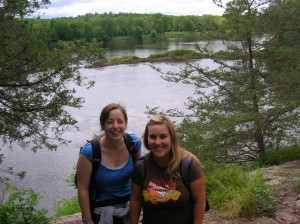This summer Laura Roberts and I headed across the pond to the Institute for Rock Magnetism (IRM) at the University of Minneapolis to attend the first ever Summer school in Rock Magnetism course being held there. We hoped this course would be useful as we both came to geomagnetism from Geology and have sometimes found our PhD’s a little overwhelming! The course itself was fascinating and covered a wide variety of topics: hysteresis, paleointensity, fine particle magnetism, remanent magnetisations to name but a few! The day was split into morning lectures which started at 8.30 (we didn’t even have a kettle available to make this early start more bearable!) followed by laboratory exercises in the afternoon. These were fascinating as the emphasis at the IRM is different to that at Liverpool and the IRM focuses a lot more on low temperature experiments. This meant we got to use a variety of new (to us!) instruments such as an MPMS (Magnetic Properties Measurement System) and a VSM (Vibrating Sample Magnetometer).
The trip also enabled us to meet a variety of other PhD and masters students from across the world (there were 11 different nationalities making up the 25 students attending the course). This gave us a great opportunity to find out about others’ research and to talk to those at a similar stage in their careers and learn how research is done at other labs. It was reassuring to know that we weren’t the only ones who felt a little confused by it all at times! We also learnt about the differences in how masters degrees and PhDs are awarded in other countries.
As part of the summer school, we were split into five groups of five, to undertake group projects, which, we worked on in the afternoons after lectures, in the lab. I found this part of the summer school very enjoyable. Each group worked on different sample types and it opened my eyes to the range of applications geomagnetism has. The aim was to characterise the magnetic properties of each group of samples. We worked on soil samples from a soil pit on University grounds; on dust samples collected in pollution monitors across Minneapolis; as well as on sea floor basalts from Iceland and the Mid Atlantic Ridge; and volcanic tuff samples from the Tiva Canyon (Yucca Mountain) in Nevada. After 7 days of experiments and hard work putting together and interpreting our results, each group gave a presentation to the rest of the class.
On our free weekend we went on a local fieldtrip which was really interesting and we visited some amazing, large glacial potholes in the Minnesota Interstate Park along the St Croix River. These potholes have been dated to the last glacial period when a torrent of water flowed south as the glaciers melted, carving the St Croix river. Where sand and gravel were caught in eddies or whirlpools in this fast flowing glacial meltwater they eroded the basalt host rock so quickly a vertical shaft was formed. There are more than 80 of these potholes in the Glacial Gardens in the park which is the greatest concentration of them in the world.
We both had a great time at the school and learnt a lot. Although unfortunately I still think we have a lot more to learn before we finish our PhD’s!
For more information and photos from the summer school see: http://www.irm.umn.edu/IRM/ssrm2011.html

